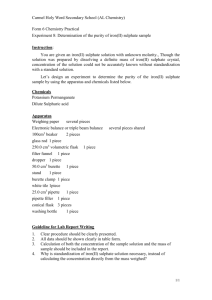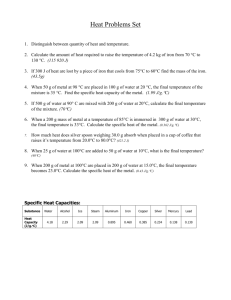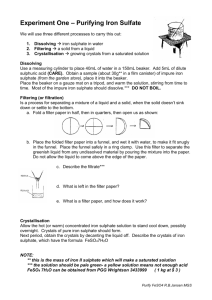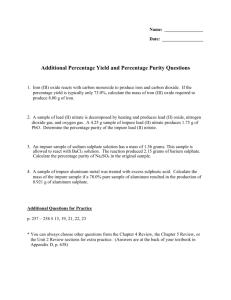Important questions from previous year question papers
advertisement
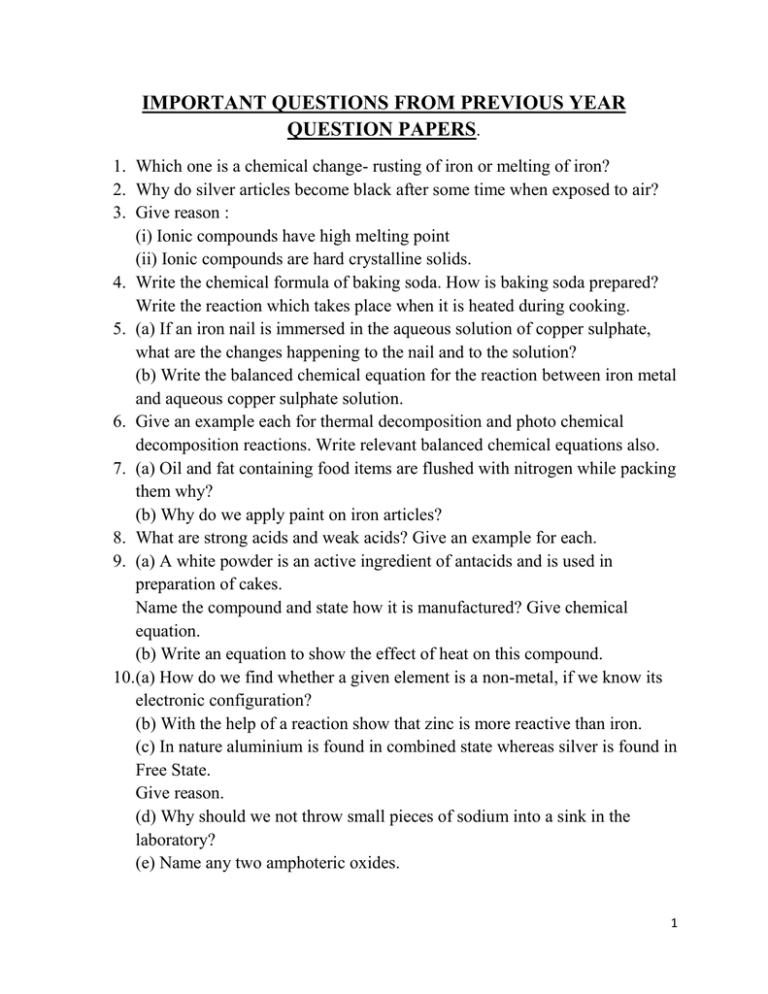
IMPORTANT QUESTIONS FROM PREVIOUS YEAR QUESTION PAPERS. 1. Which one is a chemical change- rusting of iron or melting of iron? 2. Why do silver articles become black after some time when exposed to air? 3. Give reason : (i) Ionic compounds have high melting point (ii) Ionic compounds are hard crystalline solids. 4. Write the chemical formula of baking soda. How is baking soda prepared? Write the reaction which takes place when it is heated during cooking. 5. (a) If an iron nail is immersed in the aqueous solution of copper sulphate, what are the changes happening to the nail and to the solution? (b) Write the balanced chemical equation for the reaction between iron metal and aqueous copper sulphate solution. 6. Give an example each for thermal decomposition and photo chemical decomposition reactions. Write relevant balanced chemical equations also. 7. (a) Oil and fat containing food items are flushed with nitrogen while packing them why? (b) Why do we apply paint on iron articles? 8. What are strong acids and weak acids? Give an example for each. 9. (a) A white powder is an active ingredient of antacids and is used in preparation of cakes. Name the compound and state how it is manufactured? Give chemical equation. (b) Write an equation to show the effect of heat on this compound. 10.(a) How do we find whether a given element is a non-metal, if we know its electronic configuration? (b) With the help of a reaction show that zinc is more reactive than iron. (c) In nature aluminium is found in combined state whereas silver is found in Free State. Give reason. (d) Why should we not throw small pieces of sodium into a sink in the laboratory? (e) Name any two amphoteric oxides. 1 11.(a) A student took sulphur powder on a spatula and heated it. Then he collected the gas evolved by inverting a test tube over it. Write a balanced chemical equation for the reaction taking place. What will be the action of this gas on : (i) Dry litmus paper and (ii) Moist litmus paper. (b) What is thermit reaction? Mention its application. 12.State the chemical change that takes place when lime stone is heated strongly. 13.What are amphoteric oxides? Choose the amphoteric oxides amongst the following oxides.Na2O, ZnO, Al2O3, CO2, H2O 14.What are antacids? Name two compounds which are used as antacids. 15.A small amount of ferrous sulphate crystals were heated in a hard glass test tube? (i) Write the equations involved in the above reaction (ii) Name the type of reaction that takes/ place? 16.A white salt on heating decomposes to give brown fumes and a residue is left behind. (i) Name the salt. (ii) Write the equation for the decomposition reaction. 17.(a) What happens when quick lime is added to water? (b) Write chemical equation for the above reaction. (c) Which type of reaction is this? 18.Write the chemical name and formula of washing soda. How is it prepared? Write balanced chemical equation of the reaction. 19.(a) How sodium hydroxide is prepared from sodium chloride? (b) What will be the pH of the following salts? (i) Salt made of strong acid and strong base. (ii)Salt made of strong acid and weak base. 2 20.(i) What causes rusting of iron? Design an activity to show the conditions needed for iron nails to rust. (ii) Why do we paint iron articles? 21.Pieces of four metals A,B,C and D were one by one added to four solutions, namely iron (II) sulphate, copper (II) sulphate, zinc sulphate and silver nitrate The observations made are tabulated below. Metal iron (II) copper (II) zinc sulphate silver nitrate sulphate sulphate A No reaction Displacement ------------------- ----------------------B Displacement -------------------- No reaction --------------------C No reaction No reaction No reaction Displacement D No reaction No reaction No reaction No reaction Answer the following questions based on the above information. (i) Which is the most active metal and why? (ii) What would be observed if B is added to a solution of copper sulphate and why? (iii) Arrange the metals A, B, C and D in order of increasing reactivity. (iv) Container of which metal can be used to store both zinc sulphate solution and silver nitrate solution? (v) Which of the above solutions can be safely stored in a container made up of any of these metals? 22.Hydrogen being a highly inflammable gas and oxygen being a supporter of combustion, yet water which is a compound made up of hydrogen and oxygen is used to extinguish fire. Why? 23.Name metal which react with a very dilute HNO3 to evolve hydrogen gas. 24.Write chemical equations that shows aluminium oxide reacts with acids as well as base. 25.A student dropped few pieces of marble in dilute HCl contained in a test tube. The evolved gas was passed through lime water. (i) What change would be observed in lime water? (ii) Write balanced chemical equation for the above change. 3 26.When a solution of potassium iodide is added to a solution of lead nitrate in a test tube, a reaction takes place. (a) What type of reaction is this? (b) Write a balanced chemical equation to represent the above reaction. 27.Define combination reaction. Give one example of a combination reaction which is also exothermic. 28.You might have noted that when copper powder is heated in a china dish, the surface of copper powder becomes coated with a black colour substance. (i) How has this black coloured substance formed? (ii) What is that black substance? (iii) Write the chemical equation of the reaction that takes place. 29.What is Baking soda chemically called? Give reaction involved in its preparation. Write one of its uses. 30.(a) What is an alkali? Give an example. (b) Why do HCl, HNO3 etc show acidic characters in aqueous solutions while solutions of compounds like alcohol and glucose do not show acidic character. 31.(a) Explain with an example how the metal X which is low in reactivity series and metal Y which is high in the reactivity series are obtained from their compounds by reduction process. (b) Write the electronic configurations of sodium and chlorine. Show the formation of sodium chloride from sodium and chlorine by the transfer of electrons. (c) List any two observations when a highly reactive metal is dropped in water. 32.(a) The reaction of metal X with ferric oxide is highly exothermic. Metal X is obtained from its oxides by electrolytic reduction. Identify X and write its reaction with ferric oxide. (b) Give reason to justify that aluminium oxide is an amphoteric oxide.Also give another example of amphoteric oxide. (c) Mention constituent metals present in bronze. 33.Balance the following chemical equation. MnO2(s) + HCl (aq) --------------> MnCl2 (aq) + H2O(l) + Cl2(g) 4 34.What are the products formed when magnesium metal reacts with water ? Why do the pieces of metal start floating during the reaction? 35.“Dry HCl gas does not change the colour of dry blue litmus paper”. Give reasons 36.Give reason: (i) A magnesium ribbon should be cleaned before burning it in air. (ii) The blue colour of copper sulphate solution changes when iron nails are dipped in it. 37.Define oxidation and reduction. In the reaction MnO2 + 4 HCl ---------------------> MnCl2 + 2H2O + Cl2 38.Write the balanced equation for the chemical reactions involved, when (a) Chlorine is passed over dry slaked lime. (b) Sodium bicarbonate reacts with dilute hydrochloric acid. (c) Sodium bicarbonate is heated. 39.(a)What is universal indicator? (b) Write the chemical equation involved in the preparation of sodium hydroxide. Name the process. 5

